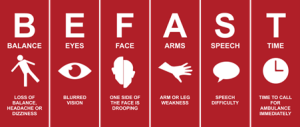A consistent supply of blood to the brain and body is required for optimal and effective function. A stroke occurs when interruption is caused to this blood supply thereby causing the brain to become damaged or parts of the brain to die. There are two main types of stroke, defined by the two ways in which they can occur:
Ischaemic stroke occurs when blood clots or other particles block the blood vessels to the brain, for example from plaque build-up. This is the more common type of stroke.
Haemorrhagic stroke occurs when an artery in the brain leaks blood or ruptures. This puts substantial pressure on the brain cells causing damage. Some risk factors that can cause this are high blood pressure or aneurysms.
One in four people globally will have a stroke in their lifetime. Stroke is the leading cause of long-term disability however the extent and severity of the effects from a stroke can be varying.
Prevention
There are several lifestyle factors which can assist in the prevention of a stroke.
- Healthy Food and Drink Choices
It is recommended to consume a variety of whole and fresh food options including all the recommended varieties from the well known food pyramid. Be sure to limit dietary sodium (salt) to lower blood pressure and consume foods low in saturated fats and trans fat for cholesterol management. Additionally, avoid drinking excessive alcohol; males should not have more than two standard drinks per day, and this is half, at one standard drink, for females.
- Physical Activity
Aim for at least 30 minutes of moderate intensity physical activity on most (preferably all) days of the week. This can be accumulated from smaller bouts of exercise or all in one go. Any mode of exercise is effective as long as it increases your heart rate, makes you feel warm and slightly out of breath. This can take form as both incidental or structured activity such as bike riding, shopping centre walking, gardening, or pool swimming.
- Medication Management
Talk to your doctor if you have concerns about your health. Individuals with uncontrolled diabetes, blood pressure, cholesterol and heart disease have an increased risk of having a stroke. Whether this is medication or lifestyle managed, it is important to have regular check ups and consult other allied health to gain appropriate support.
- Quite Smoking
Smoking doubles the risk of having a stroke as these damages blood vessel walls, increases blood pressure, reduces oxygen in the blood and increases blood clotting. If you don’t currently smoke, do not start. If you are a smoker, consult your doctor to source strategies to assist with quitting.
Management After a Stroke
The severity and type of symptoms stroke survivors experience can vary largely, and the period taken for recovery and extent of recovery is diverse as well. Some concerns may include: paralysis or weakness in one or both sides of the body, trouble with thinking, awareness, attention, learning or memory, difficulty with speech, numbness or unusual sensations, pain which can worsen with movement or bladder and bowel control difficulties.
Physical activity after a stroke should include cardiovascular and resistance exercises and should be progressive in nature. It is recommended to complete physical activity to lead to strength, walking and gait control, balance, and mental health benefits. The type of exercise which would be appropriate and most beneficial for you will change overtime. If you have any concerns, consult an Exercise Physiologist or your Doctor for appropriate support and exercise prescription.




